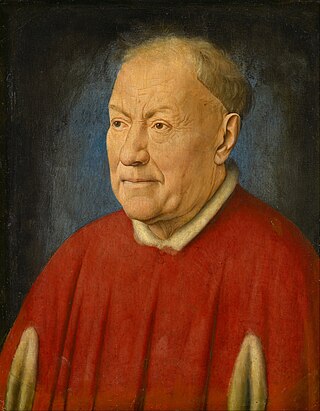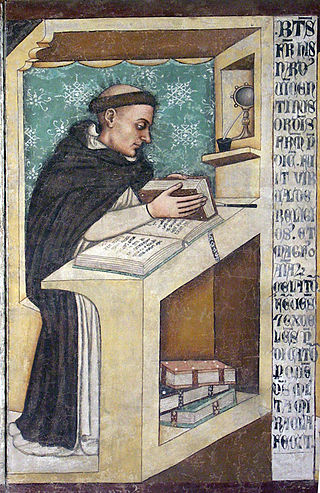Louis Aleman was a French Roman Catholic cardinal and a professed member of the now-suppressed Canons Regular of Saint John Baptist. He served as the Archbishop of Arles from 1423 until his resignation in 1440 when he had resigned from the cardinalate. But he was later reinstated as a cardinal on 19 December 1449 at which point he served as the Protopriest and also reclaimed his titular church.

Saint Dominic,, also known as Dominic de Guzmán, was a Castilian Catholic priest and the founder of the Dominican Order. He is the patron saint of astronomers and natural scientists, and he and his order are traditionally credited with spreading and popularizing the rosary. He is alternatively called Dominic of Osma, Dominic of Caleruega, and Domingo Félix de Guzmán.

Bartholomew of Braga, born Bartolomeu Fernandes and in religious Bartolomeu dos Mártires, was a Portuguese Catholic and a professed member from the Order of Preachers as well as the Archbishop Emeritus of Braga. Fernandes participated in the Council of Trent and also collaborated with Charles Borromeo at the council while also establishing a series of hospitals and hospices in Braga while publishing a range of works from catechism to other topics.

Niccolò Albergati was an Italian Carthusian and a prelate of the Roman Catholic Church. He was appointed cardinal and served as a papal diplomat to France and England (1422–23) in addition to serving as the bishop of Bologna from 1417 until his death.

Franz Josef Rudigier was an Austrian Roman Catholic prelate and served as the Bishop of Linz from his appointment in 1853 until his death. Much of his local diocese grew due to his vigorous in promoting evangelic zeal and fundamental religious principles. He became the intellectual figurehead for Catholics in their struggle with liberalism. He promoted the Christian press and took a visible stand defending the 1855 concordat, when liberals annulled it without papal consultation in 1870. A beatification process for Rudigier was initiated under Pope Pius X in 1905 and he was titled as a Servant of God. The confirmation of his life of heroic virtue allowed for Pope Benedict XVI to name him as Venerable in 2009.

Augustin Kažotić was a Croatian prelate of the Catholic Church and professed member from the Order of Preachers who served as the Bishop of Lucera from 1322 until his death. Kažotić was a humanist and orator who had served first as the Bishop of Zagreb from 1303 until 1322. Kažotić studied in Paris before returning to his homeland where he began working in the missions and preaching in modern Bosnia. He was one of the first humanist figures to appear in southern Croatia.

Pio Alberto del Corona - born Alberto del Corona and in religious Pio - was a Roman Catholic Italian prelate and the founder of the Suore Domenicane dello Spirito Santo. He served as the Bishop of San Miniato from 1897 until his resignation one decade later. The bishop served as a humble pastor though reluctant as he was to accept his episcopal appointment while even protesting against an idea to elevate him into the cardinalate. He exercised his duties until ill health forced him to resign from his see though was given a ceremonial position since Pope Pius X did not wish to relieve him of all his episcopal duties and functions.

Andrea Franchi was an Italian Roman Catholic member of the Order of Preachers who served as the Bishop of Pistoia before his resignation due to ill health. Franchi became a noted preacher and evangelist who was also known for his holiness and his deep commitment to the poor of his diocese.

Domenico Spadafora was an Italian Roman Catholic priest and a professed member of the Order of Preachers. Spadafora was a noted evangelist and attracted countless to the Dominican fold while also converting the hearts of others who led dissolute lives. He is best known for being the first superior of a church he oversaw construction of in Monte Cerignone after receiving the papal approval of Pope Alexander VI to commence such work.

Elena Duglioli was an Italian Roman Catholic aristocrat from Bologna noted for her devotion to Christian life and social teachings. Duglioli wanted to become a nun for the Poor Clares but instead married in order to please her parents. Duglioli is best known for commissioning a chapel with an image of Saint Cecilia to whom she was devoted.

Nicola Paglia was an Italian Catholic priest and member of the Order of Preachers. Paglia became a Dominican after hearing Dominic de Guzmán preach in Bologna and exhibited exceptional pastoral zeal in his duties which included being appointed as provincial of the Roman branch of Dominicans.
Rinaldo da Concorezzo was an Italian Roman Catholic priest and archbishop who served as the Bishop of Vicenza from 1296 until his 1303 appointment as the Archbishop of Ravenna-Cervia holding that until his death.
Giacomo Benefatti was an Italian Catholic priest and professed member of the Order of Preachers who ascended to the position of Bishop of Mantua. Benefatti became noted for his tender care of the ill during epidemics of plague and both Pope Benedict XI - a close personal friend - and Pope John XXII held him in high esteem.

Giacomo Bianconi was an Italian Roman Catholic priest and a professed member of the Order of Preachers. Bianconi - who hailed from Umbria - joined the order in his adolescence and dedicated his pastoral career to his flock and on one notable occasion aided refugees when Frederick II sacked the area in 1248. He also combatted heresies and managed to convert one of their chief propagators while also distinguishing himself through his life of extreme poorness that went past the Dominican standards.

Alberto da Bergamo, TOSD was an Italian Catholic farmer from Bergamo and a professed member of the Third Order of Saint Dominic. He was married in his adulthood to a wife who disapproved of his generous nature to the poor before her conversion and death, and he spent his initial widowhood going on several pilgrimages to Rome as well as visits to both Spain and Jerusalem.
Blessed Hartmann of Brixen was a German prelate of the Catholic Church, who served as the Bishop of Brixen from his appointment in 1140 until his death. Hartmann served alongside the Order of Saint Augustine - who oversaw his education - and he managed certain aspects of their order despite not being part of that congregation. He also supported Pope Alexander III during his struggle with Frederick Barbarossa and also earned the favor of the latter despite Hartmann's views of the schism.
Bonaventura Tornielli was an Italian Roman Catholic priest and a professed friar from the Servite Order. Tornielli was born into a noble household and was a noted preacher in which he visited numerous Italian cities such as Florence and Perugia - Pope Sixtus IV held him in high esteem and even named him the "Apostolic Preacher". He also held various positions of leadership within his order.
Antonio Pavoni, OP was an Italian Catholic priest and member from the Order of Preachers. He served as an inquisitor-general for Pope Urban V in combatting Waldensians in the Lombard region, but the Waldensians succeeded in killing him in an ambush as he preached an Eastertide homily in 1374.

Isnardo da Chiampo, OP was an Italian Catholic priest and professed member in the Order of Preachers.
Enrico da Settala, sometimes anglicized Henry of Settala, was the archbishop of Milan from 1213 until his death.














